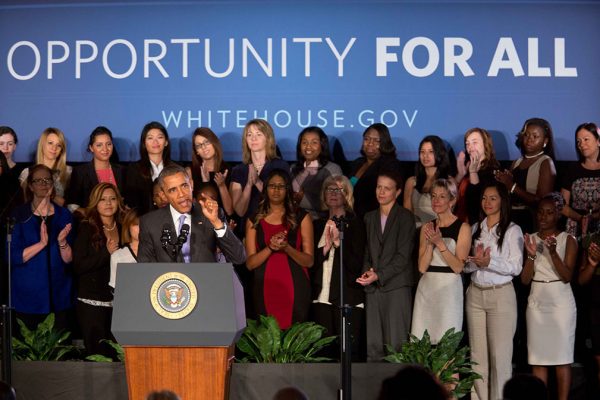The hyperpolarization of the American political system threatens the long-term health of democracy. Jacob Hacker and Paul Pierson have convinced me that it creates an important moment of opportunity for Democrats. But their increasingly “U-shaped” base poses a real danger, both for the party and the nation.
Hacker and Pierson ask how Biden has been able to propose such a bold economic agenda despite growing reliance on affluent voters. One reason for suburban realignment that they don’t mention is the specter of the new Republican Party. The GOP’s embrace of Trumpism over the last decade has profoundly alienated moderate suburbanites, sending them fleeing to the Democrats. Yet Trump and his allies are not the only reason for this exodus, nor for the purportedly paradoxical voting patterns of this group.
Many high-income professionals understand that Biden’s policies are not really at odds with their values and economic interests. Since the 1950s suburban residents have shown concern about environmental issues, so their support for Biden’s effort to combat the climate crisis is not surprising. Moreover, affluent suburbanites consistently prioritize pocketbook issues that offer them material rewards, and in many ways Biden’s economic agenda has actually aligned with these priorities. Reliable child care and elder care are concerns not only of low-income people but many middle- and upper middle-class ones as well—especially dual-career households, as the pandemic made all too clear. Biden’s child care subsidies extended into the upper reaches of the middle class, as did his changes to the child tax credit. Places like Washington, D.C., that have introduced universal pre-K have seen it utilized by residents of all economic levels.
Biden’s loan forgiveness program also stood to benefit highly educated professionals, many of whom have accrued debt in pursuing their own academic training or in paying for their children’s higher education. The American Jobs Plan’s provisions for tax credits for electric vehicles, along with its subsidies for green energy and organic farming, aligned with many affluent professionals’ values and consumer spending habits, and the bill would have created affluent job opportunities in areas like engineering. The list goes on.
Of course, Hacker and Pierson are right that the Biden administration has not seriously challenged the “opportunity hoarding” rampant in affluent suburban and urban neighborhoods. Issues like affordable housing have long been the third rail of suburban politics. But there are ways to address the nation’s dire housing crisis that could resonate with a cross-class coalition. Perhaps most pressing is policy focused on increasing housing supply. Middle-class professionals, particularly those in major cities who are finding it difficult to purchase property, would stand to benefit from more housing stock. And since housing is perhaps the primary concern of most low-income urban voters of color, it could also help Democrats ensure that this key constituency heads to the polls. (These voters are not at risk of defecting en masse to the GOP, but their fluctuating turnout matters a great deal.)
For all these reasons, Democrats could even more doggedly pursue a progressive and redistributive economic agenda, especially on universal benefits such as care and climate, and they could stand to be much more aggressive in their housing agenda than they have been. This universalist focus could more strongly fuse the interests of the two ends of its U-shaped coalition.
Yet this coalition also has its perils, evident in the large portion of the country and voters it leaves out. As with the realignment of suburban voters, rural voters’ embrace of the GOP stems from both political economy and changes within the Republican Party. And this shift has troubling implications, both for the stability of the Democratic coalition and the nation as a whole.
Hacker and Pierson note that Democratic leaders are not blind to this reality; indeed they hypothesize that it is one of the reasons for Biden’s leftward shift on economics. With the 2024 election drawing closer, the administration recently made an even more concerted effort to promote this focus by orchestrating a two-week tour to show how it is “Investing in Rural America.” Last fall, Biden and members of his cabinet stormed through battleground states including Arizona, Georgia, Indiana, Iowa, Michigan, North Carolina, Pennsylvania, and Wisconsin to highlight the nearly $5 billion—funded through money earmarked under the Inflation Reduction Act and the American Rescue Plan along with executive actions—that they have put toward conservation, economic development, and “climate smart” agriculture, including investment in high-speed internet and renewable energy in rural areas.
But this focus on rural communities is less of a break from the past than it might appear. Indeed, it echoes attempts by the Clinton administration to ensure that low-income rural residents were not left behind by the new information economy. Biden’s approach is more wide-reaching than what Clinton offered in the late 1990s, but even his agenda fails to grapple with the past and take responsibility for—or at the very least acknowledge—the fact that many rural voters blame Democrats for the economic dislocation wrought by globalization. This widespread frustration with Democratic policies of the past is one of the reasons that Hacker and Pierson’s vision of “building power through policy” has not gained much traction in these areas of the country.
If Democrats are serious about investing in rural America, they need to do more than visit rural areas for photo ops and stump speeches in election years. Among other things, this means devoting resources to rebuilding grassroots infrastructure during off-election years by embracing the tactics of veteran community organizers like George Goehl and groups like People’s Action—tactics such as deep canvassing, rooted in long, empathetic conversations that focus on listening rather than persuading. These approaches are less flashy and more time-consuming than high-profile visits, but they have proven more effective at building trust of rural residents. These kinds of actions would reduce the “density tax” that Hacker and Pierson discuss—and help Democrats reshape their congressional map as well.
In 2018 Matt Lassiter and I wrote an article for the New York Times arguing that Democrats should stop worrying about affluent suburbanites. I still believe that. Six years ago a sizable portion of that constituency could still be characterized as swing voters; today they have become a stable part of the Democratic Party’s coalition, and so long as the Republicans continue to present themselves as the party of MAGA, they will remain so. This development frees up the Democrats to devote more of their energy and resources to other groups and parts of the country. These steps would ensure both a party and a country that serves everyone and lead to a Democratic coalition that resembles more of a filled-in circle than a hollowed-out U.
Boston Review is nonprofit and relies on reader funding. To support work like this, please donate here.






